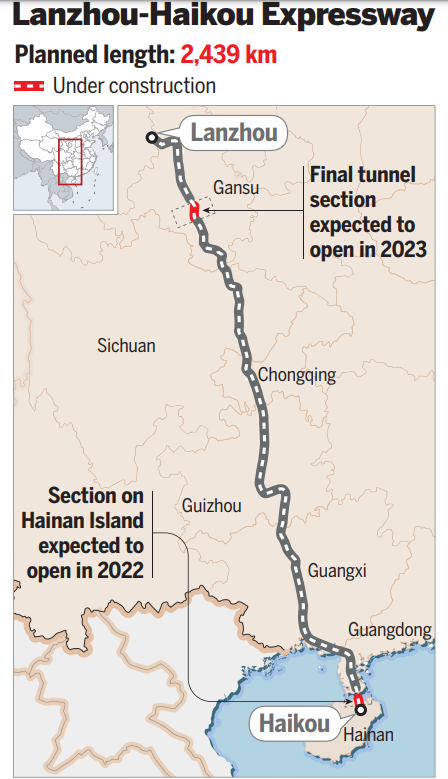Expressway an economic engine for inland areas

Road to wealth
The road not only reaches developed coastal areas leading overseas, but also links to rural roads to benefit countryside residents.
Liang Rong built a garden on a hill at Ersheng township in Chongqing's Banan district that opened to tourists in 2014 and quickly attracted many visitors from the city with its beautiful countryside views of blossoms.
But Liang received many complaints because the 4-meter-wide road down the hill to the garden could not accommodate buses, and two cars could only pass each other slowly, easily leading to traffic jams.
A new 9-meter-wide asphalt road that opened in 2019 has changed the situation and made Liang very happy.
"Visitors can even take buses to our garden," he said, adding that the widened road has led to expansion of the business, which now receives not only individuals and families as tourists but also groups organized by travel agencies.
"The new road connects with expressways such as the G75 and G50 (from Shanghai to Chongqing) to bring visitors from nearby big cities," Liang said.
With people flocking to the garden, locals opened about 30 small hotels to offer them accommodation.
"Local villagers, including me, have become richer thanks to the road," he said.
The ministry said that in some relatively isolated areas, the G75 provided the first fast path to the outside world. Its Longnan section in Gansu is the first highway in the area, making travel between Gansu and Sichuan more convenient.
Several sections in Guangxi are also the first expressway in the region.
Challenging work
The complicated geographic and geological conditions along the expressway posed challenges to its builders and designers, Wang from the ministry said.
Most of it runs through mountainous areas, including those in Gansu, Chongqing and Sichuan.
"It was quite challenging to build tunnels and bridges back in the 1990s and early 2000s," he said.
The geographic conditions were also quite complicated along sections in Guizhou and Guangxi.
Though most of the road has been completed, improvement has never stopped.
"As one of China's earliest expressways, the G75 has been improved over the years," Wang said.
Expansion projects have been carried out to cater to increased traffic on some busy sections, such as those in Chongqing, Guizhou and Guangxi, and the road's condition has also been improved, he added.
Local culture
One of China's longest expressways, the G75 passes many cities and villages, and in the southern section in Guangxi it passes several areas that are home to ethnic groups including the Zhuang, Yao and Miao.
A service area along the expressway between Nanning and Beihai in Guangxi has incorporated elements of "Na" culture, the traditional culture of the Zhuang ethnic group, including selling traditional ornaments and food, as well as displaying cultural exhibits.
It is a promotion to introduce "Na" culture to more people, said Yu Ling, manager of the service area, adding that Zhuang people live nearby.
"Visitors stop at the service area, take a break and get a chance to know the 'Na' culture," she said. "That means the traditions of the Zhuang ethnic group can reach more people via the expressway network."
China opened its first expressway, connecting Shanghai and the satellite town of Jiading, in 1988, when developed countries, such as the United States and Germany, already had expressway networks in place.
Though late to the game, China has caught up fast, and the G75 is part of a freeway network that now spans 160,000 km, ranking first in the world.
The development of the expressway network reflects China's accomplishments in infrastructure construction.
According to a high-profile transport plan, by 2035, China will have built a freeway network that allows residents of most county-level regions to reach an expressway in half an hour.














